#east-european shepherd
Text
was having therian thoughts. made a self-indulgent moodboard. here she be

#i dont. make these very often lmao#so it's probably not great#therian moodboard#east european shepherd therian#canine therian#therian
64 notes
·
View notes
Text
Every so often I'm reminded of these dogs and it fucking sends me every time

57 notes
·
View notes
Note
hey there! i enjoy your outfit boards immensely :-)
would you mind creating one for an east european shepherd (dog)? specifically a black and pale tan one! masc/androgynous leaning — would be nice for it to be mostly covering clothing (because the sun absolutely hates me) if possible.
ty in advance either way,, and i hope you have a lovely day :}
- @houndsmaw

I got you!!! I hope you enjoy!
#Dog therian#East european shepherd therian#dogkin#therian fashion#therian fashion board#therian outfits#therian outfit board
15 notes
·
View notes
Note
hello! your boards are very pretty /gen
could i get a board for an east european shepherd (aka VEO) dog? themes of the cold/snow (<- in a 'desolate cold' way) and k9 work would be cool to see, but are optional! ty in advance, if you choose to make it :}
- @houndsmaw
Hello! It has been posted. I do dearly apologize if anything is wrong, I am not familiar with this dog breed and never heard of it until this, ahah. I hope you enjoy your moodboard and feel free to request again someday.
#💕 Fangs In - Request Accepted#dog therian#canine therian#east european shepherd therian#therian#nonhuman
5 notes
·
View notes
Text
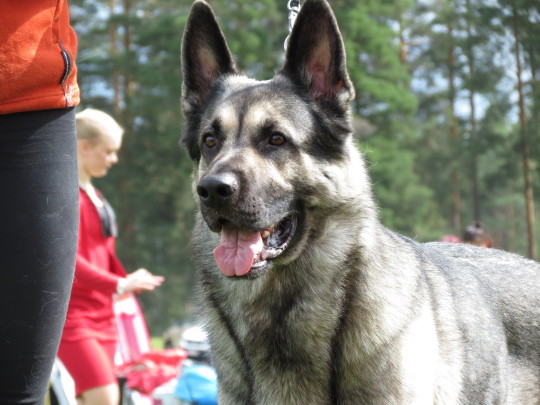





#1st one ran straight into me (while sitting) after doing a lap of the ring LMAO#east european shepherd#they're big#dog show#dogblr#pics#mine
1 note
·
View note
Text
People online: Zionism is colonialism!! Stop eraseing the natives!
Genetic studies: umm. Well, actually -
I'm not biologist! But I try to explain this in simpler words. Feel free to correct me if I misunderstood anything :)
(can't believe I spent about 4 hours on it)
In short - the study compared the Y genes of several different groups - aka the paternal genetic history (father-to-son).
Finding more similarities= genetically closer= has a more common ancestry.
(like, brother is closer then cousin closer then a stranger)
Let's start!
"The investigation of the genetic relationship among three Jewish communities revealed that Kurdish and Sephardic Jews were indistinguishable from one another, whereas both differed slightly, yet significantly, from Ashkenazi Jews. The differences among Ashkenazim may be a result of low-level gene flow from European populations and/or genetic drift during isolation."
AKA: genetically speaking, there's no difference between Jews from various MENA countries (Mizrahim). (Sephardic were mostly Moroccan origins, Kurdish sample mostly north Iraq/Syrian origins)
An important note: Eda refers to the spesific traditions/subgroup, and passed down by the paternal line (father-to-son). This is in order to preserve traditional practices, that were different in different communities (e1)
There's a small genetic difference between Mizrahi jews and Ashkenazi Jews. This could be due to isolation or "low level gene flow" (in other words, converts and (mostly) children born from rape. Which was... way more common then you think. Look up "Pogrom".)
Next!
In a report published elsewhere, we recently showed that Jews and Palestinian Arabs share a large portion of their Y chromosomes, suggesting a common ancestry (Nebel et al. 2000). Surprisingly, in the present study, Jews were found to be even closer to populations in the northern part of the Middle East than to several Arab populations. It is worth mentioning that, on the basis of protein polymorphisms, most Jewish populations cluster very closely with Iraqis (Livshits et al. 1991) and that the latter, in turn, cluster very closely with Kurds (Cavalli-Sforza et al. 1994). These findings are consistent with known cultural links that existed among populations in the Fertile Crescent in early history.
Here, the mention earlier studies about genetic links between Jews (of all Edot) and Palestinian arabs. This can mean there's a common ancestry to the population (same grand-grand-etc.-father).
Jews are geneticly similar to Iranians, who are geneticly similar to Kurds (e2)
Those genetic links aren't suprising, and consistent with what we know from history about population and communities in the Fertile Crescent area.
Muslim Kurds
The Kurds are considered an ancient autochthonous population (Kinnane 1970; Pelletiere 1984) who may even be the descendants of the shepherds who first populated the highlands during the Neolithic period (Comas et al. 2000). Although Kurdistan came under the successive dominion of various conquerors, including the Armenians, Romans, Byzantines, Arabs, Ottoman Turks, and Iraqis (Kinnane 1970), they may be the only western Asian group that remained relatively unmixed by the influx of invaders, because of their protected and inhospitable mountainous homeland (Pelletiere 1984). The Y chromosome variation of Muslim Kurds falls within the spectrum observed in other populations (Turks and Armenians) living in the same region. The three populations are closer to Jews and Arabs than to Europeans. This is in good agreement with data on classical markers (Cavalli-Sforza et al. 1994). However, on the basis of mtDNA polymorphisms, Kurds were reported to be more closely related to Europeans than to Middle Easterners (Comas et al. 2000).
Kurds are very ancient ethnic group. Possibly the only western-asian group that remained relatively unmixed, despite (pointing history).
Kurds Y chromosomes are pretty similar to those in the same area (Turks and Armenians), and those three groups Y chromosomes are more similar to Jews and Arabs then to Europeans.
Now, that's interesting: the similarities is also in classical markers, but it's different from studies on mtDNA (Maternal/mother line), which then shows more similar to Europeans than Arabs and Jews.
(idk if there are rumours/historical kurds stories/traditions about Patriarch communities with brides from distance? Or Matriarch communities with grooms from the (other) distance? But it sounds like the historical story is something like that.
Palestinian Arabs and Bedouin
Bedouin are largely nomadic Arab herders, with a tribal organization. They live in all Arab countries, constituting about one tenth of the population (Cavalli-Sforza et al. 1994). The Bedouin population of the Negev desert was found to be most distant from Jews and Muslim Kurds and to be closely related only to Palestinians. Both these Arab populations differ from the other Middle Eastern groups sampled for the present study, mainly in having a higher frequency of Eu 10 chromosomes, the majority of which they share with each other. Traditional marriage practices—such as male polygamy, a high rate of consanguineous marriages, and patrilocality—may have enhanced the low haplogroup and haplotype diversity of the Negev Bedouin, as was suggested elsewhere for the Bedouin tribes in the Sinai Peninsula (Salem et al. 1996).
Bedouins from the Negev (Southern Israel) were most different from Jews and Muslim-kurds, and closely related to Palestinian Arabs. Both Arab groups were(geneticly) very similar to eachother, but different from the other Middle Eastern groups in the study.
The main difference was a higher frequency of Eu 10 chromosomes, that were similar in the 2 groups.
We propose that the Y chromosomes in Palestinian Arabs and Bedouin represent, to a large extent, early lineages derived from the Neolithic inhabitants of the area and additional lineages from more-recent population movements. The early lineages are part of the common chromosome pool shared with Jews (Nebel et al. 2000). According to our working model, the more-recent migrations were mostly from the Arabian Peninsula, as is seen in the Arab-specific Eu 10 chromosomes that include the modal haplotypes observed in Palestinians and Bedouin. These haplotypes and their one-step microsatellite neighbors constitute a substantial portion of the total Palestinian (29%) and Bedouin (37.5%) Y chromosome pools and were not found in any of the non-Arab populations in the present study. The peripheral position of the modal haplotypes, with few links in the network (fig. 5), suggests that the Arab-specific chromosomes are a result of recent gene flow. Historical records describe tribal migrations from Arabia to the southern Levant in the Byzantine period, migrations that reached their climax with the Muslim conquest 633–640 a.d.; Patrich 1995). Indeed, Arab-specific haplotypes have been observed at significant frequencies in Muslim Arabs from Sena (56%) and the Hadramaut (16%) in the Yemen (Thomas et al. 2000). Thus, although Y chromosome data of Arabian populations are limited, it seems very likely that populations from the Arabian Peninsula were the source of these chromosomes. The genetic closeness, in classical protein markers, of Bedouin to Yemenis and Saudis (Cavalli-Sforza et al. 1994) supports an Arabian origin of the Bedouin. The alternative explanation for the distribution of the Arab-specific haplotypes (i.e., random genetic drift) is unlikely. It is difficult to imagine that the different populations in the Yemen and the southern Levant, in which Arab-specific chromosomes have been detected at moderate-to-high frequencies, would have drifted in the same direction.
The eu10 Y chromosomes geneticly linked to the arab peninsula, and wasn't found in non-arab population. It's very possible that arab-Palestinians and Bedouins are the descendants of immigrants and population movement, possibly during the Caliphate - the Muslim Empire (Arab dynasties 632-1258; Mamluk Sultanate 1250-1517; ottoman/turkish 1517-1924) (e2)
Example and more information undercut:
Eda (plural - Edot): community, subgroup. Usually refers to a group using different Minhagim (traditions).
For example, my Yemeni ancestors only said the "Hamotzi" prayer (said before eating bread) during Passover, as wheat was rare and expensive, and wasn't a usual part of their diet.
Another differences include Te'amim (ways to read the Torah. Sort of like 🎶 for voice); Kitniyot (o lo lithiyot/jk) - do you eat it on passover? What about the oil?; certain holidays (traditional Mimuna, Sigd.) (Yat kislev🙈)
Through history, even though most Jewish communities weren't completely isolated from one another, it still took a lot of time to pass questions and information. So different places gained different traditions.
Basically, it goes "(go by) paternal traditions" (מנהג אבות)
In the past, people that moved from one community to another would take over the new traditions.
Since moving and immigration became far more common, and started to move as communities, people kept their traditions. For example, in my area I have 5 small synagogues, each was founded by a community from different diaspora that wanted to keep their traditions.
And it's okay! It's even great 😸
(e2) kurds:
Oh look, another ethnic group fighting for freedom and right for self government.
Population: about 30m ppl worldwide. In current geography, the land split between Iraq, Syria and Turkey. Also fighting ISIS. Look up YPJ.
#genetic studies#israel#palestine#genetics#genetic screening#kurdistan#kurds#muslim#jews#arab#arab peninsula#Palestinians#Bedouin#biology#history#fascinating#iraq#syria#turkey#YPJ#ncbi#peer review#science#biology study
16 notes
·
View notes
Text

Recently, a copy of Alpines & Bog Plants by Reginald Farrer fell into my hands (thank you, antiquarian bookseller). At first I thought it would be botany but it is actually a mix of hobbyist naturalist & horticultural anecdotes.
It’s a first edition, published in 1908 -- remarkably well kept, pretty obvious spotting & foxing and one plate appears to be detaching from the spine. The book is remarkably poetic, but it would be free verse with binomial nomenclature, which I haven’t seen before,

The dedication is an excerpt from Hippolytus by Eurypides, roughly (according to my friend who studies classics):
“For you, lady, I bring this plaited garland I have made, gathered from an inviolate meadow,
a place where the shepherd does not dare to pasture his flocks (except rabbits), where the iron scythe has never come;”
In Hippolytus this is spoken to Artemis, but in this case the dedication is to Farrier’s mother which is heartwarming :)
Here I will note that the idea of “nature” as something undisturbed (ungrazed, unharvested) is central to the colonial conceptualisation of ecology and has contributed to the forceful removal of indigenous peoples from their land (and the subsequent loss of biodiversity, as humans are not separate from nature and we can play an important role in ecosystems)
Not calling Eurypides or this book inherently bad/colonial (more on the book & colonialism later) but this idea is def present in modern ecology and colonialism and important to highlight when present.
The book is full of black&white photographic plates which have held up really well for being over a century old. The plates themselves are beautiful:



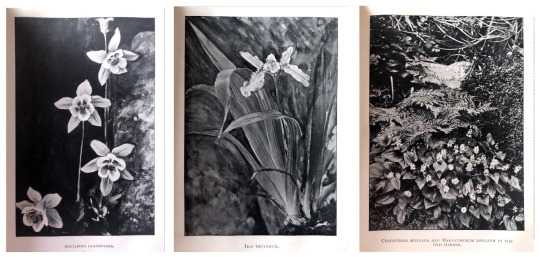
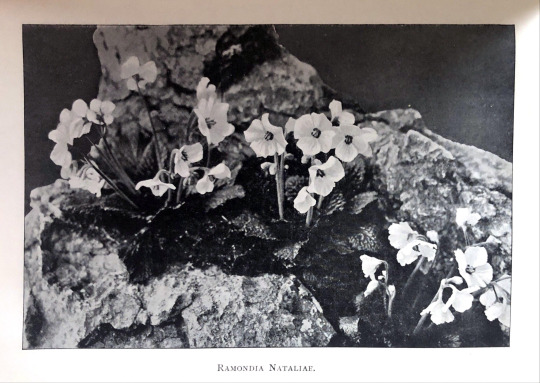


The photographs were taken in Farrer’s own garden. Little snapshots of the past :)!!
The text content of the book is quite intriguing and not all good, definitely carries heavy cultural baggage as does modern Western biology in general. I will preface this by saying I have absolutely not battled my way through this book, but I have read sections. there is a definite 1900s-Englishman tone in all the ways that can mean. part of that is most certainly a degree of both xenophobia and orientalism. When venerating the beauty of the wilderness and of Japanese/Chinese garden design, there is obvious othering in the language used & Farrer is dismayed at the effects of cultural transmission (this is most notably in European gardens attempting to mimic the artistic style of east Asian gardens but using the “wrong” plants, usually European plants rather than importing non-native varieties that are more “authentic”). Farrer was deeply in love with Asian biota and was notable for collecting plants to bring back to Europe, and while I cannot speak on Farrer’s techniques specifically, such practices are deeply intwined in racism and colonialism. In many cases, economic systems & resulting hardships forced on other cultures by Europeans allowed them to exert control over certain groups, stripping them of agency and employing them to extirpate “uncooperative” groups. I haven’t found anything re:Farrer in this context but it is essential to place the entire book within this context!!
However the majority of the book is Farrer describing gardening as well as his travels to collect plants for propagation in the UK (notably he died while on one such plant-collection travel). Apparently (& corroborated by the preface) the plants he searched for were ones that would grow well in the UK w/o much care, to make having a cool garden more accessible regardless of income. so if a plant needed extensive care and things like hothouses, it was not his priority.

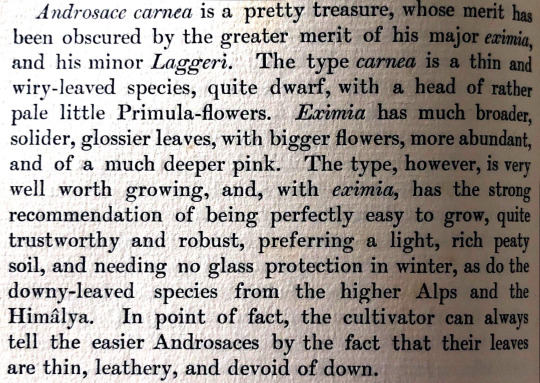
The way he describes plants is vaguely anthropomorphised in a generally appealing way, trying to make the reader appreciate the plant for things such as hardiness and robustness, which I suppose would align w/ the idea of making gardening easier. also in the sense that the robustness is tied in with beauty as well, as these features are of course not opposed to one another.
I may snoop through this book further to see anything else , we will see.
#library#antique books#antiquarian books#natural history#antique photography#history#books#old books#botany#gardening#horticulture#ecology#dark academia#miaow#osedax bookblog
64 notes
·
View notes
Text

Polina Shepherd (Skovoroda) was born in Tomsk, Russia. Now an internationally renowned singer, she brings the songs of the Steppes and the Shtetl up to date with passion and haunting soul. Her singing, based on traditional forms, is deeply rooted in east European Jewish and Russian folk. Growing up in Tatarstan placed her close to Islamic ornamentation, which can be heard in her unique vocal style. (x)
#i just pinned this specific song bc that's the one i've been vibing too all morning lol#Bandcamp#polina shepherd
28 notes
·
View notes
Note
Hello, with your experience with wolfdogs, would you say high-contents have more behavioral similarities with -
Huskies
Laikas & other nordic/boreal hunting spitzes
"Pariah" dogs
Nihon ken & other east asian hunting spitzes
Central European shepherds types?
I'm currently not in a spot where wolfdog ownership is feasible, I'm just curious about their behavior. I know that wolves & wolfdogs are more intense in some behaviors than domestics, but are there any quirks specific to them? Sorry for longish ask.
Hmmm.
I'd say they're probably most similar to pariah dogs, because they lack selection for some of the more extreme behaviors like prey drive that continues even once full/sated, guardian nature, pull drive, etc that the other varieties of primitive dogs you listed tend to have, as those breed types all stemmed from selective breeding to make more prominent the traits they needed.
The only thing I've personally seen in high contents that I haven't seen in dogs of any breed, is seasonal behavior changes, because dogs don't experience the immense hormonal shift that wolves do. A male wolf's testicles are the size of small grapes most of the year with relatively low testosterone production, but they experience a 300% increase in testosterone in winter and the testicles swell in preparation for breeding season.
As you can imagine, this change can make them more sensitive during winter months. Some get very "mushy" and affectionate, like Zephyr and her relatives do, but some other lines tend to become protective of their space and their mate, territorial, and when they're improperly imprinted into humans instead of other canines due to bottle-feeding, it can cause them to view humans as a "challenger/opponent" for their mate, creating conflict and aggression.
The animals who experience more intense seasonal changes and who are handled poorly through it causing escalation get labeled with "winter wolf syndrome", although the sad truth is that the term came from an animal who was severely mishandled thru his own seasonal changes. Two Feathers would have likely been fine like his siblings were, had his owners practiced de-escalation and redirection and not taken offense to his hormone shifts and kicked the fence, yelled, smacked him, etc when he was moody.
15 notes
·
View notes
Text
A major new work, weaving together historical anecdote and the author’s family history, laments the slow erasure of centuries of linguistic, ethnic and cultural diversity in an increasingly homogenised region.
In Goodbye, Eastern Europe, a major new work “chronicling a thousand years of strife, war, and bloodshed” from Vienna to the 14 time zones of the Russian Empire, Jacob Mikanowski weaves a rich and amusing tapestry of historical anecdote (and personal family history). His aim is to explode conceptions of Eastern Europe as a grey, featureless bloc – but also to suggest that millennia of tolerance, cosmopolitanism and cultural, linguistic and ethnic variety are slowly being erased. While his epilogue links this diagnosis to the Russian invasion of Ukraine, Mikanowski’s thesis has perhaps even greater relevance to the Western Balkans.
His historical vignettes are delightful – thieves in the finicky Austro-Hungarian Empire handed four-hour sentences for stealing an onion, elderly Romanian communists leaving Kent Cigarettes on graves to pay black-market bribes in the afterlife – but also serve a larger purpose. This tissue of anecdote is the perfect way for Mikanowski to demonstrate Eastern Europe’s “defining characteristic is diversity”. Each page revealing another “little island of heterodoxy”, down to the ultra-fine level where each village has its minority and each minority its particularities, as in the exhaustive account of a Ukrainian settlement where even the cabinetmakers had their own culture: “As Filippians and Old Believers, they spoke Russian, but with a Novogorod accent.”
To Mikanowski, the phrase “Eastern Europe” is an “outsider’s convenience”, a lump term of little practical application to locals. His argument here recalls Maria Todorova’s “Imagining the Balkans”, which powerfully demonstrates the negative, politically-loaded role of the term “Balkans” – as implied by the always-pejorative neologism “Balkanisation” – applied by outside observers and commentators to a shifting set of states and territories while many of those states try to escape the charge.
As with, for example, Romanian writers claiming a Latin identity to evade the “Balkan” label, Mikanowski notes that particularly in the post-Communist era, many Eastern European countries prefer to consider themselves in “Central Europe”, the “Nordic Community”, and so on, thus distancing themselves from the Eastern Bloc. The Balkans are, perhaps, another such an exception, but with the difference that the term is applied from the outside. Rather than a breakaway clinging to Mitteleuropa (Hungary) or Russia (Belarus), they’re isolated and abandoned – the last island of Eastern Europe.
Mikanowski does sketch the deep diversity and (sometimes uneasy) tolerance which has long characterised the Western Balkans – as well as pointing to the mushrooming of latter-day nationalism and ethnic homogenisation. For example, he takes a fascinating trip to Moschopolis in Albania, the “city of the shepherds”, which was for centuries the heart of the little-studied Vlach culture, but whose Christian churches are now largely shuttered.
Overall, the book has less to say about the Western Balkans than other regions. States are covered in the expected proportions, with Poland mentioned around 230 times, but Bulgaria 50 times and Serbia 40, with Montenegro and Kosovo only just reaching 10. This reflects Mikanowski’s Polish-Jewish origins, personal research interests and certain geopolitical realities, but also suggests the extent to which the Balkans represent Eastern Europe’s own East, encoding the same values for other Eastern Europeans as Eastern Europe itself does to the West.
Nonetheless, his arguments can provide a key for understanding the region, for example when claiming polities like the Poland-Lithuanian Commonwealth (represented here as the avatar of its contemporary, fledgling US) and the Ottoman Empire were not “nuclear winters” for culture. Rather, they “tended to accentuate difference rather than suppress it”, in the latter case particularly by fostering the “largest and oldest concentration of Muslims on the European continent”, whose contributions are often overlooked when set against Umayyad Andalusia. As with Christopher Clark’s recent effort to rehabilitate the much-maligned Austro-Hungarian Empire, to Mikanowski there is much to commend these vast and unwieldy institutions, which discriminated against minorities while simultaneously allowing for unprecedented religious toleration on the basis of recognized differences.
With these arguments, Mikanowski aims to push back against simplistic, atavistic nationalisms which have defined the post-Communist era – as when he derides the phalanxes of nationalistic statuary in Skopje, or critiques post-ideological, third-way museums in Hungary for implying communism was “just as bad” as Nazi fascism, in a charge equally applicable to contemporary nationalist ideologues in the Western Balkans. At the same time, he cautions, it’s “easy to fall into nostalgia” when discussing Eastern Europe’s pre-World War 1 diversity. Most cities were not “melting pots”, but characterized by mutually suspicious, if tolerant, communities – as in Albania’s Elbasan, once partitioned in sharply-defined concentric circles of Christian Albanians, Muslim Albanians and Christian Vlachs.
Mikanowski’s anecdotal style is less suitable for identifying other meta-historical trends or making political claims. As with the genealogy craze, everyone finds their own great-grandfather’s story fascinating – but what can this tell us about the course of history?
In such a grand narrative, something is always downplayed, and Mikanowski’s focus is on the personal and local. Understandably, the writer is more concerned with tracing the miserable fate of intellectuals under Stalinist communism than any deep-searching assessment of Communist political economy. He has sympathy for Hungarian “Goulash communism” and respect for Tito’s Yugoslavia as the sole anti-Stalinist “exception” and bane of Stalin’s life but doesn’t delve into how it was that Tito could by and large preserve inter-ethnic diversity and solidarity, instead somewhat simplistically presenting the Yugoslav project as an “act of mutual forgetting”.
Rather, the full impact of Mikanowski’s string of personal anecdotes is revealed when he turns to his family’s experiences in the Holocaust. Pushing back against representations of the slaughter of six million Jews as solely an “impersonal, mechanized process”, marked by German efficiency, Mikanowski argues that in Eastern Europe, “the Holocaust was an intimate slaughter”, as neighbour turned on neighbour in an exhaustive, hand-to-hand massacre. Thus, the author, in the book’s most profoundly affecting passage, can trace his great aunt Rosa’s scream as she was executed in the Warsaw ghetto via a secret milk-can archive, preserving the memory of her murder to the present day, where it “haunts” him yet.
Long-term persecution of the Jews and Roma notwithstanding, cataclysmic 20th-century violence was in part so horrific precisely because minorities had lived cheek-by-jowl with their persecutors for so long, in what Mikanowski calls a “ramshackle utopia”, weathering prejudice and the rise and fall of empires.
Mikanowski’s warning over the dangers of homogenisation and decline of this long-standing cosmopolitanism is particularly germane to the Balkans – all the more so in the neo-liberal free-for-all which followed the Socialist collapse. The Jews are gone, the Islamic presence is much diminished, and regional capitals are an increasingly indistinguishable blur of co-working spaces and Starbucks, masking empty rural hinterlands left to the impoverished, the elderly and the ghosts. But so too is his celebration of a “constellation of parochialism… bigger than the sum of its parts”, traces of which still endure in those same hinterlands, despite all efforts to eradicate it.
7 notes
·
View notes
Text
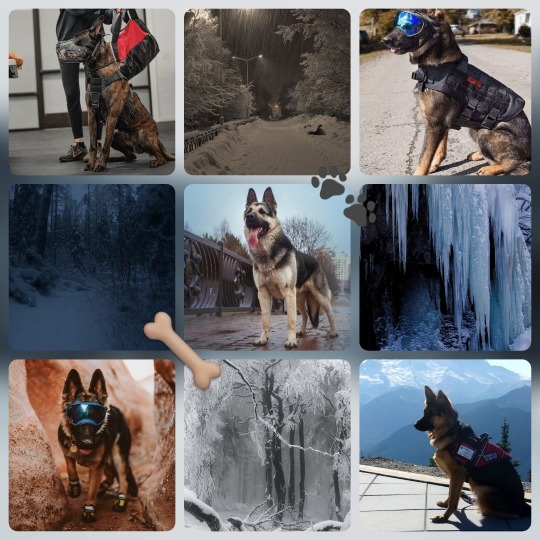
East European Shepherd moodboard with themes of snow / desolate cold and working canines for @houndsmaw
I hope you enjoy the moodboard. I apologize for the wait and if anything is wrong, especially the dog in the middle, I do hope it is the right breed.
#🖤 Moodboards#eastern european shepherd therian#dog therian#canine therian#therian#nonhuman#therian moodboard#dog moodboard#snow moodboard#canine moodboard#moodboard
15 notes
·
View notes
Text
Re: the post I reblogged earlier, a series of Reid Wiseman's cool orbital photos taken on the ISS? Specifically, the first picture that has a bit of a mystery in it? This one:

I think I know what that is, and I am going to tell you how I figured it out (pre-emptive apologies to any South-East Asians who feel the urge to headdesk while reading this post.)
First off, all that green glow? It's on water. Check out a map of the area:

So why are there lights in the sea at night? Well, squid fishing happens at night, and the ships use bright lights to imitate the moon to attract the squid.
Here's a big squid-fishing ship, filmed by a drone off the Argentinian east coast in the Atlantic Ocean. It's got a bit of green going on.

Here's another one, photographed in the Pacific. Also some green here.

Both of those are, however, severely outdone in greenness by this small Thai squid-fishing ship.
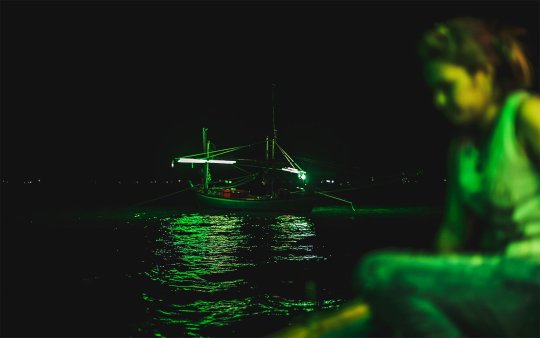
Unlike the previous examples, it is in the right place and is, in fact, All Green. Boy, is it green. Look at how green it is. It is So Green.
Before you say that puny ships like that cannot possibly be visible all the way up to the ISS, consider: a) that there might be a bajillion of them, and b) the big ships are also out there in even bigger fleets, and they are bloody bright.
According to the Sea Shepherd organisation, who tracked a 300-strong squid-fishing fleet west of the Galapagos Islands in 2018, "the total luminosity of these vessels is said to rival European soccer stadiums". They waxed a bit poetic about them:
"Suddenly out of the darkness a towering intense white light showed on the horizon. Soon it was followed by others all around us, mostly white but some an iridescent green and others with dimmer yellow light. Looking out from the wheelhouse we seemed no longer to be on the open ocean but in the edge of some great coastal metropolis."
Here's part of a fleet of some 150 ships near Argentine.
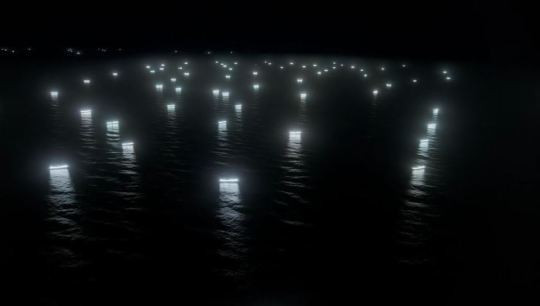
And here's that same fleet again, managing to be a magnificent eyesore even at a considerable distance.

Sure, Argentine is pretty far away from Bangkok (though those ships might also be Chinese). But South-East Asia definitely has some of its own night-light activity going on. You can find a handy map at globalfishingwatch.org (go play with it, it's fun). It didn't have night-light satellite data from 2014, but here's a snapshot from August 2022 for comparison.
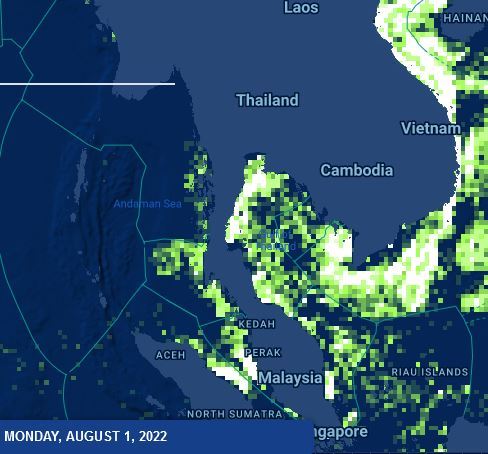
The map also shows national fishing zones. If I'm interpreting Wiseman's photo correctly, those green lights in it are in the Vietnamese, Malesian and Indonesian waters. So those are likely Vietnamese, Malesian and Indonesian squid-fishings ships (and maybe some other nationalities that maybe aren't supposed to be there; here's that Sea Shepherd page again and an article about the Global Fishing Watch project talking about that kind of thing).
What I sadly couldn't figure out is what kind of squid they're fishing over there. I was hoping it might be the Japanese flying squid, because then I would have a reason to put them in this post. Unfortunately, Japanese flying squids apparently don't live that far down South.
But I'm going to put them on this post anyway, because I just found out about them, and I mean, look at these guys:

Just Look.
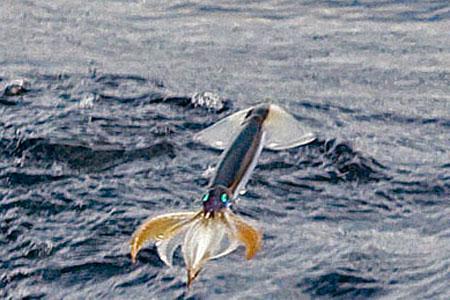
They're like if a squid decided it wanted to be a flying fish and instead of making a deal with the sea witch, it went "I can do it! I can! I can!" They're sleek, attention-grabbing and ridonculous. They can fly over 30 metres in 3 seconds. And they're not being caught by the glow-in-the-dark squid-fishing fleet off the Gulf of Thailand because they don't live there, and therefore have nothing whatsoever to do with the rest of this post.
But they're cool.
Finally, a confession: I didn't figure out the lights because I know something about South-East Asian fishing practices (I know nothing, feel free to laugh and correct me), or because did some kind of a systematic elimination chain to eventually arrive at the answer (ahahahaha no). It's because I've watched the Patagonia: Life on the Edge of the World nature documentary no less than three times in less than two weeks, and there's footage in it of this massive unnerving squid-fishing fleet, which you'll definitely remember if you've seen it once, let alone three times.
Why have I seen it three times, then? Obviously for very normal reasons. Not at all because the series is narrated by Pedro Pascal. I mean, who would opt to listen to Pedro Pascal talking very seriously about (occasionally horny) wildlife for 4+ hours while endearingly lisping his Fs and THs here and there? Not me, no. I am very normal about him and not at all soothed by his dulcet tones in my time of stress. Don't look at me.
#squid fishing#earth from space#pedro pascal (tangentially)#listen people I am currently gearing up to go to battle with my local health care system#so tonight I needed an all-consuming low-stakes distraction like a fish needs water#and it was either gonna be this or 5682324 rounds of evil sudoku and “can I get past 400 000 points” tetris and a carpal tunnel syndrome#I figured out the green lights in under a minute and then spent five hours researching and writing this post backwards from the conclusion#just like they taught us in science school#and THEN I rewrote the whole thing because tumblr ate the first version#because CLEARLY tumblr needs to know all about mysterious green squid murder lights from eight years back even if it does not want to#In an improved alternate reality Pedro Pascal has a busy side career narrating nature documents#and one of them is five seasons of him yelling about deep sea creatures with the Nautilus researchers#someone really needs to show Pedro Pascal a dumbo octopus and then ask him to explain black smokers in his own words#this is a very niche kind of fantasy and I'm sticking with it
11 notes
·
View notes
Text
Bungou Stray Dogs daemon AU
Kunikida
his Daemon’s name Izumi (Famale). she settled as a German Shepherd- actually she’s a East European Shepherd but no one really cares about details. ahh idk when they settled since we know nothing about Kunikida’s story.

Dazai
his Daemon’s name is Shizuko (Female). she settled as a Caracal when they’re almost 16. Everyone thought that when they settled it would be this big dramatic thing but really they just woke up one day the they were settled. they didn’t even tell anyone about it until a few days later when they casually mentioned it to Chuuya and Kitsu
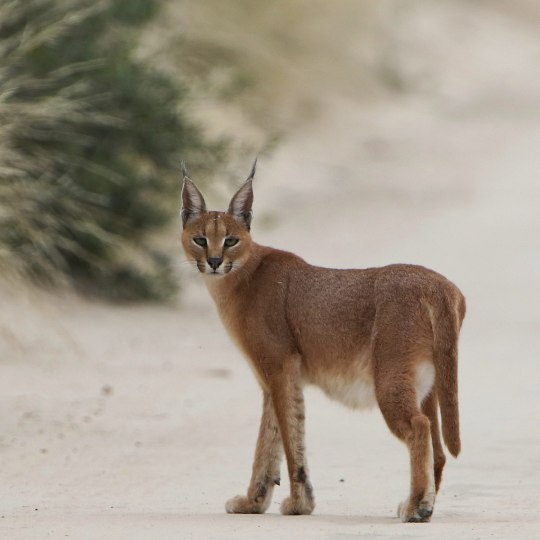
Ranpo
his Daemon’s name is Moroto (Male). he settled as a Raven after they met Fukuzawa, i haven’t actually watched the latest season yet so i don’t know much about their story
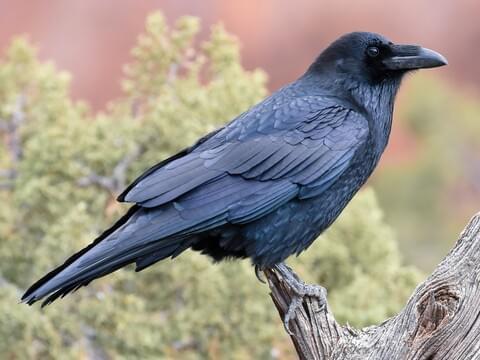
Yosano
her Daemon’s name is Kaoru (Male). he settled as a Nightingale during the Great War. (if you can’t tell, i also don’t know much about her story.)
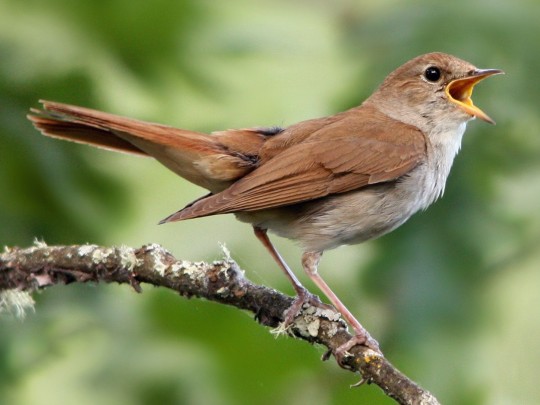
Atsushi
his Daemon’s name is Yuan (they didn’t even know what gender was for a long time and she thinks its stupid to limit yourself to just one). She settled as a Pygmy Rabbit when they jumped off of the train with Kyoka and Taro during ep 8 (yes, it’s as small as it looks)

Kyoka
her Daemon’s name is Taro (Male leaning but also doesn’t really care, so Demiboy). they Settled as a Snow Petrel at the end of season 2, when they’re talking to Dazai and Shizuko before the crash the plane into the Moby Dick

Junichiro
his Daemon’s name is Seki (Female). she settled as a Prairie Dog sometime before they joined the ADA? again, we don’t know much about their story yet

Naomi
her Daemon’s name is Jokichi (Male). he settled as a Dhole before Junichiro (we need their story!!)

Fukuzawa
his Daemon’s name is Yoshi (Male). he settled as a Grey Wolf pretty early and is big for a Daemon, hell he’s big for a wolf even (wow we really don’t know much about characters early life do we? This is getting really annoying.)

now for some bonus characters because the PM part is gonna take me a while
Katai
his Daemon’s name is Okada (Female). she settled Tree Python not long after Kunikida and Izumi settled, so whenever that was.

Chuuya
his Daemon’s name is Kitsu (Female). she settled as an Ethiopian Wolf during that one scene in stormbringer. yeah that one, you know the one.

Kenji is not on here because he hasn’t settled yet
#bungou stray dogs#bungo stray dogs#bsd#kunkida#doppo kunikida#bsd kunikida#dazai#bsd daz#dazai bungou stray dogs#dazai x chūya#ranpo#ranpo bungou stray dogs#ranpo bsd#ranpo edogawa#yosano#bsd yosano#bungou stray dogs yosano#atsushi#bsd atsushi#atsushi nakajima#kyoka#kyoka bsd#kyoka izumi#tanizaki junichirou#bsd tanizaki#bungou stray dogs tanizaki#tanizaki naomi#bsd naomi#fukuzawa yukichi#bsd fukuzawa
9 notes
·
View notes
Text
Jayhawks Tour Update March 2023

We will be adding some new summer and fall 2023 tour dates soon. Stay tuned to The Jayhawks website and social media for the latest updates.
Tour dates & ticket links: bit.ly/JayhawksShows
Next up is our first trip to Europe in a few years. Tim O'Reagan had to drop out at the last minute due to circumstances beyond his control but we have recruited Austin, Texas drummer Conrad Choucroun to fill in. Conrad has played with many artists over the years - NRBQ, Bob Schneider, John Doe, Patty Griffin, Ron Sexsmith, et al - and we're very happy he was able to bail us out on such short notice. The only other alternative was to cancel or postpone these dates, some of which have already been pushed back (see: COVID). Tim will be back on the drum throne for our April east coast dates.
European dates
April 7 - Blue Heart Festival - Alkmaar, Netherlands
April 8 - Heartland Festival - Hengelo, Netherlands
April 10 - Nalen - Stockholm, Sweden
April 11 - Pustervik - Goteberg, Sweden
April 12 - Slagthusets Teater - Malmo, Sweden
April 14 - O2 Shepherds Bush Empire - London, England

Later in April we will be on the east coast for 4 dates with Freedy Johnston opening all shows. Port Washington, Tarrytown and Fairfield are sold out, but check back closer to the show date in case any tickets get released. There are still tickets remaining for Jersey City.
East coast dates
April 26 - White Eagle Hall - Jersey City, NJ
April 27 - Landmark on Main Street - Port Washington, NY (SOLD OUT)
April 28 - Tarrytown Music Hall - Tarrytown, NY (SOLD OUT)
April 29 - Sacred Heart University Community Theatre - Fairfield, CT (SOLD OUT)
8 notes
·
View notes
Text
6 notes
·
View notes

